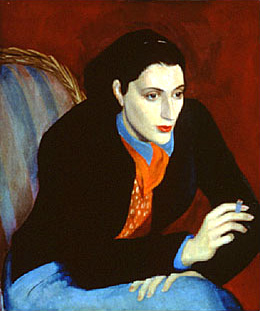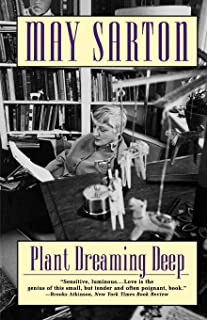- Read
- On The Writer
- On The Writing
- Favorite Quotes
- Photos
- Film and Audio
- Bibliography
- News
- Order Books
One Who Persists review by Jeanne Braham
"One Who Persists": A bouquet of titles by and about perennial favorite Sarton is as welcome as flowers in MayIt must be gratifying and more than a little bewildering for May Sarton to float buoyed on the tide of recent critical discourse about her work. Although the author of more than 40 books of poems, novels, journals, and memoirs has always enjoyed a wide popular audience, only recently has she received serious critical attention. In her introduction to Mrs. Stevens Hears the Mermaids Singing, Carolyn Heilbrun singled out Sarton's work as meritorious and brave, a writer "unusually courageous, unusually generous, unusually overlooked."
In the last decade her critical recognition has grown steadily, solidified by the work of Constance Hunting (May Sarton: Woman and Poet, 1982), Elizabeth Evans (May Sarton Revisited, 1989), and Heilbrun's continuing acclaim posited in chapters of Writing a Woman's Life (1988) and Hamlet's Mother and Other Women (1991).
Within the last three years, a flurry of Sarton celebration and assessment has appeared: Conversations with May Sarton (edited by Earl Ingersoll, 1991), That Great Sanity, Critical Essays on May Sarton (edited by Susan Swartzlander and Marilyn Mumford, 1992), and A House of Gathering (edited by Marilyn Kallet, 1993). To this must be added Endgame, a journal published on the occasion of her 80th birthday; a national conference of scholars and artists celebrating her 80th birthday held at Westbrook College; publication by Norton of her collected poems; and, most recently, the subjects of this review: Encore A Journal of the Eightieth Year and May Sarton: Among the Usual Days, A Portrait, a collection of letters, journals, poems, and photographs edited by Susan Sherman.
Sarton acknowledges this avalanche of acclaim in Encore, carefully distinguishing between the undifferentiated praise of "fans" and the serious practitioners of criticism who grapple with the organic nature of her work. In describing Sandra Gilbert's paper at the Westbrook Conference as a "thrilling, complex and respectful reading of my poems," Sarton admits it "was the accolade I have longed to be given before I die. What a strange sense of arrival after a long journey it gave me."
Layered Memories of a Vibrant Past
Encore, like Sarton's earlier journals At Seventy and After the Stroke, documents her efforts to separate duties and chores from literary work demanding "primary intensity," a process strained if not drained by ill health and increasing dependence on others for some of life's routine tasks. Because the journal is dictated (a secretary then transcribes and Sarton edits), the reader misses some of the felicity of language that marked Sarton's earlier journals, particularly her habit of choosing images, "essences" as she called them, that link landscape to interior consciousness. Gone are the descriptions of the seasons, the cycles of the sea, the antics of birds and pets that animated journals like Journal of a Solitude and House By the Sea.
Encore's gaze is inward, its test the consciousness that comes when one recognized that time is limited. Layered memories of a vibrant past rise up: friendships with Jean Dominique, Virginia Woolf, and Eva LaGallienne coexist in equal force with current friendships, each registering its primary color, and each imbuing the others with richness. Sarton suggests that her journals have forced her "to try to be honest ... not to pretend that things are better than they are, but to learn to evaluate without self-pity or self-glorification what has been happening to me." In this sinewy purpose Encore succeeds.
May Sarton: Among the Usual Days juxtaposes unpublished letters, journals, poems, and photographs and in that process recovers the distinctive voice of Sarton speaking on the page. Sarton recognizes this with unmistakable joy when she acknowledges in the introduction: "What I might write about the past could not have the freshness of a letter written forty years ago. So in a way Susan has given me back a self I had nearly forgotten."
Rather than spanning six decades of Sarton's adult life chronologically, the passages are arranged by subject to illustrate many of her lifelong passions: writing, drama, gardening, travel. Sherman is careful to efface herself, and her deft editorial hand remains invisible, keeping the reader's eye squarely on the subject. What emerges is a record of Sarton's creative and intellectual development as well as a fiery portrait of, as Sarton characterized herself, "one who persists." Here are the "rages" that fuel not only the abundant flow of poems, novels, and letters but also trigger bouts of serious depression. Here is the woman who longs to "pour herself into another," a desire navigated more successfully in her poems than in her life. And here is her sacramentalization of the ordinary, surely the artistic donne of her journals, captured in a tribute to Virginia Woolf: "perhaps her greatest gift (comparable to Emily Dickinson) was to make the ordinary things of life, a woman knitting a sock, a certain light on the grass, marvelously new and touching."
A fierce and unflagging devotion to the work, "the whole work [which] belongs together as a part of a total vision of life" stitches these passages into a seamless whole. In this devotion Sarton parallels fellow New Englander Donald Hall who, while also acutely conscious of "time's winged chariot," honors work above all else, the intricate and difficult detailing of the artist's life calling.
From Belles Lettres: A Review of Books by Women; 04-30-94 V.9; N.3 p. 35; reprinted by permission.
Source: https://www.mermaidssinging.com/BellesLettresReview.htm





